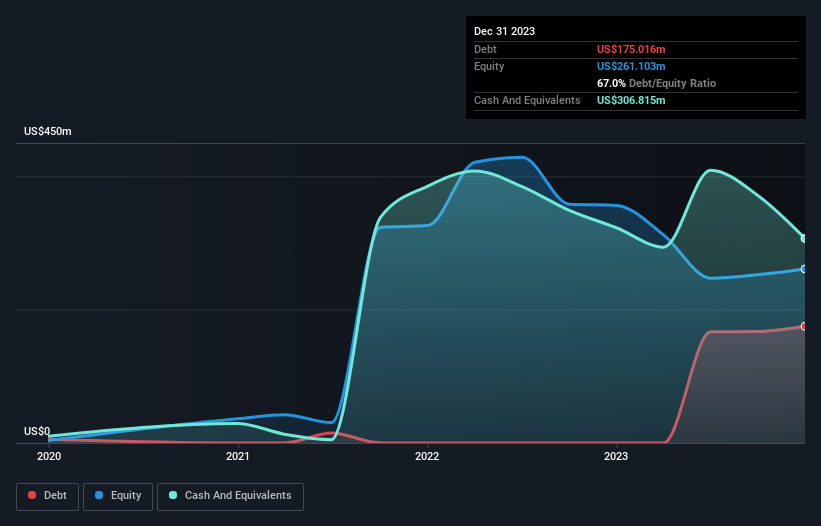- United States
- /
- Electrical
- /
- NasdaqGS:ENVX
Health Check: How Prudently Does Enovix (NASDAQ:ENVX) Use Debt?
Some say volatility, rather than debt, is the best way to think about risk as an investor, but Warren Buffett famously said that 'Volatility is far from synonymous with risk.' It's only natural to consider a company's balance sheet when you examine how risky it is, since debt is often involved when a business collapses. We note that Enovix Corporation (NASDAQ:ENVX) does have debt on its balance sheet. But is this debt a concern to shareholders?
Why Does Debt Bring Risk?
Generally speaking, debt only becomes a real problem when a company can't easily pay it off, either by raising capital or with its own cash flow. In the worst case scenario, a company can go bankrupt if it cannot pay its creditors. While that is not too common, we often do see indebted companies permanently diluting shareholders because lenders force them to raise capital at a distressed price. Of course, debt can be an important tool in businesses, particularly capital heavy businesses. The first step when considering a company's debt levels is to consider its cash and debt together.
Check out our latest analysis for Enovix
What Is Enovix's Net Debt?
The image below, which you can click on for greater detail, shows that at December 2023 Enovix had debt of US$175.0m, up from none in one year. However, its balance sheet shows it holds US$306.8m in cash, so it actually has US$131.8m net cash.

How Strong Is Enovix's Balance Sheet?
We can see from the most recent balance sheet that Enovix had liabilities of US$61.0m falling due within a year, and liabilities of US$242.2m due beyond that. Offsetting this, it had US$306.8m in cash and US$2.42m in receivables that were due within 12 months. So these liquid assets roughly match the total liabilities.
This state of affairs indicates that Enovix's balance sheet looks quite solid, as its total liabilities are just about equal to its liquid assets. So while it's hard to imagine that the US$1.60b company is struggling for cash, we still think it's worth monitoring its balance sheet. Succinctly put, Enovix boasts net cash, so it's fair to say it does not have a heavy debt load! When analysing debt levels, the balance sheet is the obvious place to start. But ultimately the future profitability of the business will decide if Enovix can strengthen its balance sheet over time. So if you're focused on the future you can check out this free report showing analyst profit forecasts.
In the last year Enovix wasn't profitable at an EBIT level, but managed to grow its revenue by 23%, to US$7.6m. Shareholders probably have their fingers crossed that it can grow its way to profits.
So How Risky Is Enovix?
By their very nature companies that are losing money are more risky than those with a long history of profitability. And we do note that Enovix had an earnings before interest and tax (EBIT) loss, over the last year. And over the same period it saw negative free cash outflow of US$166m and booked a US$214m accounting loss. But at least it has US$131.8m on the balance sheet to spend on growth, near-term. Enovix's revenue growth shone bright over the last year, so it may well be in a position to turn a profit in due course. By investing before those profits, shareholders take on more risk in the hope of bigger rewards. When analysing debt levels, the balance sheet is the obvious place to start. However, not all investment risk resides within the balance sheet - far from it. For instance, we've identified 3 warning signs for Enovix that you should be aware of.
At the end of the day, it's often better to focus on companies that are free from net debt. You can access our special list of such companies (all with a track record of profit growth). It's free.
Valuation is complex, but we're here to simplify it.
Discover if Enovix might be undervalued or overvalued with our detailed analysis, featuring fair value estimates, potential risks, dividends, insider trades, and its financial condition.
Access Free AnalysisHave feedback on this article? Concerned about the content? Get in touch with us directly. Alternatively, email editorial-team (at) simplywallst.com.
This article by Simply Wall St is general in nature. We provide commentary based on historical data and analyst forecasts only using an unbiased methodology and our articles are not intended to be financial advice. It does not constitute a recommendation to buy or sell any stock, and does not take account of your objectives, or your financial situation. We aim to bring you long-term focused analysis driven by fundamental data. Note that our analysis may not factor in the latest price-sensitive company announcements or qualitative material. Simply Wall St has no position in any stocks mentioned.
About NasdaqGS:ENVX
Enovix
Designs, develops, and manufactures lithium-ion battery cells in the United States and internationally.
High growth potential with excellent balance sheet.
Similar Companies
Market Insights
Community Narratives




